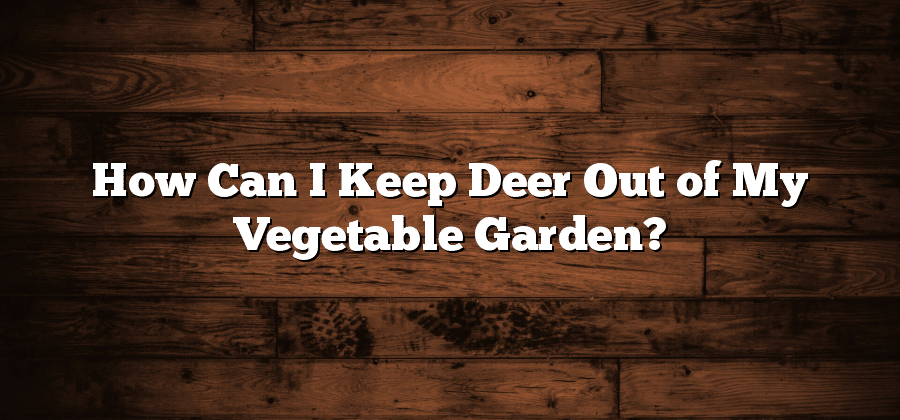Understanding deer behavior and preferences
Deer behavior and preferences play a crucial role in understanding and managing their presence in our surroundings. These majestic creatures, known for their cautious nature, exhibit specific behavior patterns that dictate their feeding, mating, and movement habits. By comprehending these aspects, we can take informed steps to minimize human-deer conflicts and create a balanced coexistence.
When it comes to food preferences, deer exhibit a discerning palate. They are particularly drawn to a wide array of vegetation, including tender shoots, leaves, twigs, and fruits. However, they tend to show a preference for certain types of plants, such as roses, hostas, and various ornamental shrubs. It is also crucial to note that deer have a keen sense of smell, enabling them to detect and locate food sources even from a considerable distance.
Choosing deer-resistant vegetable varieties
When gardening, it is essential to consider which vegetable varieties are less appealing to deer. These animals can wreak havoc on your carefully cultivated plot, devouring your hard work and leaving you with little to show for your efforts. To minimize the risk of deer damage, choosing deer-resistant vegetable varieties is a wise choice.
One vegetable that is generally not appealing to deer is the tomato. While they may occasionally nibble on the leaves, tomatoes are typically low on their menu preferences. Varieties such as Roma, San Marzano, or beefsteak tomatoes are often safe choices. Additionally, peppers, both sweet and hot varieties, are often left untouched by deer. Opting for bell peppers, jalapenos, or habaneros can give your vegetable garden a kick without enticing the local deer population.
Implementing physical barriers for deer deterrence
As homeowners, gardeners, and farmers, we all know the struggle of keeping deer away from our precious plants and crops. Implementing physical barriers is a highly effective method for deterring these graceful but destructive creatures. When it comes to deer deterrence, prevention is key, and physical barriers offer a reliable and long-term solution.
One of the most common physical barriers used for deer deterrence is fencing. Deer fencing should be sturdy, tall, and difficult to climb or jump over. The height of the fence should be at least 8 feet to prevent deer from leaping over it. Additionally, the spacing between the fence posts should be close enough to prevent deer from squeezing through. Whether you choose a wire mesh fencing or a wooden picket fence, make sure it is properly installed and well-maintained to effectively keep deer at bay. Remember, an investment in quality fencing is an investment in protecting the beauty and bounty of your landscape.
Installing effective fencing options for deer control
Deer can cause significant damage to gardens and crops, which is why installing effective fencing options is crucial for deer control. Fences act as a physical barrier, preventing deer from accessing your property and feasting on your delicate plants. When selecting a fence for deer deterrence, it is important to choose a sturdy and tall option. Deer are agile jumpers and can easily clear low fences. Opt for a fence that stands at least eight feet tall to ensure maximum effectiveness.
A popular choice for deer control is the deer netting fence. This type of fence is made from durable polypropylene material, which is both lightweight and resistant to weather conditions. The netting is designed with small mesh openings to prevent deer from squeezing through. Additionally, the black color of the netting helps it blend easily with the surroundings, making it less noticeable. To install the deer netting fence effectively, ensure that it is securely fastened to sturdy posts every six to eight feet. This will prevent deer from pushing it down or slipping underneath.
Utilizing natural deer repellents and deterrents
Deer can cause significant damage to gardens, crops, and landscapes, making it important to find effective methods of deterring them. Natural deer repellents and deterrents offer a compelling solution that does not harm the animals or the environment. One commonly used natural deer repellent is the use of strong-smelling substances. Odor-based repellents, such as predator urine or soap bars, can be strategically placed in the garden to create an unpleasant scent that deer find repulsive. Additionally, repellents made from natural ingredients, such as garlic or hot pepper, can also be sprayed on plants to deter deer from feeding on them. These natural repellents rely on strong smells or tastes to create a barrier that deer are less likely to cross.
Another effective natural deterrent is the use of motion-activated devices. These devices, equipped with sensors, can detect the presence of deer and activate mechanisms that produce loud noises, flashing lights, or sudden movements. This unexpected response effectively startles the deer and sends them running in the other direction. Additionally, some motion-activated deterrents emit sound or ultrasonic frequencies that are not audible to humans but are highly irritating to deer. By utilizing these natural deterrents, homeowners can humanely protect their gardens and crops from deer damage.






